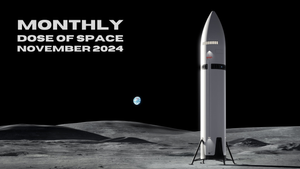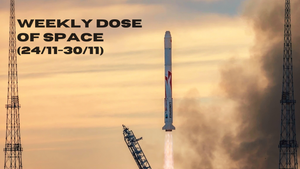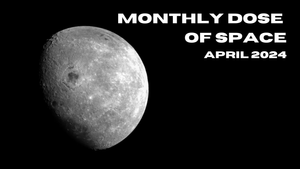
Monthly Dose of Space - April 2024
Welcome to our seventh Monthly Dose of Space! In this monthly newsletter, we bring you major news from the past month we haven't covered in our weekly newsletters. April has been another busy month, so let's jump into it!
SpaceX
Work at Starbase this month started with the removal of thermal protection tiles from the nose of Ship 29, this may be from some data gathered from flight three about the performance of the tiles. Work continued on the tiles into the morning of the 2nd when some tiles were added back onto the nose. The 2nd also saw the Orbital Launch Mount do what is believed to be a test of one of its vents. On the 3rd, teams were once again spotted working on the nose tiles of Ship 29.
Late at night on the 3rd, Booster 11 was rolled out to the launch site before being parked next to the Orbital Launch Mount. Not long after arrival, Booster 11 was moved into the 'chopsticks' and lifted onto the launch mount in the early hours of the 4th. Also on the 4th, Ship 29 was moved outside which revealed that large number of heat tiles were being replaced along the vehicle. Early on the 5th of April, scaffolding was removed from the Orbital Launch Mount along with a crew access platform ahead of a static fire.
The 5th saw Booster 11 come to lift and perform what was believed to be a thirty-three engine static fire for over five seconds. SpaceX did not share how many engines lit or the duration.
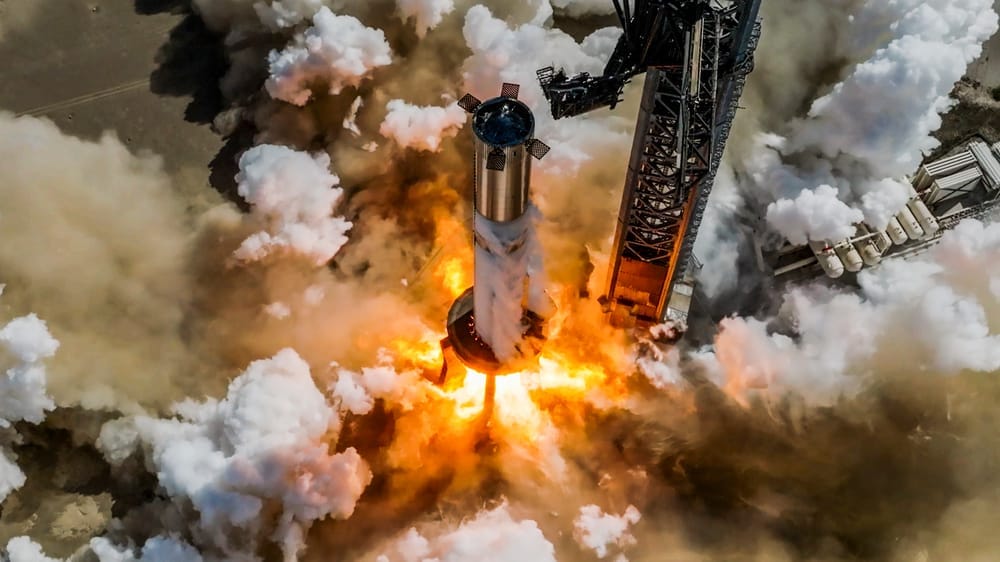
After this static fire, Booster 11 was removed from the Orbital Launch Mount on the 7th. In the late hours of the 7th, Booster 11 was rolled back to the production site and moved into one of the 'mega bays'. A few days later on the 9th, workers were spotted still working on Ship 29's nose cone thermal protection tiles.
Early on the 10th, workers were seen removing the front cover of the booster quick disconnect on the Orbital Launch Mount. The 10th also saw workers installing almost all of the missing thermal protection tiles on Ship 29's nose cone. A few days later, the 12th saw a new actuator being installed on the 'chopsticks' of the launch tower as well as a new booster quick disconnect front cover being installed.
Activity then slowed until the 16th, when workers were spotted on the launch towers 'chopsticks' conducting what are believed to be upgrades ahead of the fourth flight of Starship-Super Heavy. A day later on the 17th, the LR 11000 crane was seen moving to the orbital tank farm, likely to continue removal of the older tanks. Also on the 17th, the 'chopsticks' were seen opening and closing, mostly likely testing new upgraded hardware.
Late on the 18th, the 'chopsticks' were seen moving again along with the removal of one of the booster quick disconnect fuel lines. Another day later on the 19th, the outer shell of one of the tanks of the orbital tank farm was almost entirely removed and lifted by the LR11000 crane. The outer shell was then moved next to the road where crews began scrapping it.
Work on the now removed tank continued and it was in pieces by the roadside by the early morning of the 22nd. In the early morning of the 23rd, the tank that now has no shell was removed from the tank farm by the LR11000 crane with scrapping work beginning shortly after.
A day later on the 24th, the booster quick disconnect cover was spotted being reinstalled on the orbital launch mount. Later in the evening, the 'chopsticks' were also seen moving, likely to test an actuator that was installed last week. Also that evening, Booster 13 was moved from the production site to the Massey's test site for a cryo-proofing test. A couple days later on the 26th the 'chopsticks' were seen moving again, this time moving faster than previously observed.
Booster 13 underwent a cryo-proofing test early on the 27th fully loading its liquid methane tank, this test is believed to have been successful but SpaceX did not confirm this.
Two days later on the 29th, Booster 13's liquid oxygen tank also underwent a cryo-proofing test at the Massey's test site, SpaceX also did not comment on the testing. To end the month on the 30th, SpaceX conducted another fast test of the 'chopsticks' along with the tank farm.
News of the Month
April saw news from both space stations in low Earth orbit, a new lunar spacesuit, and a new rocket breathing fire ahead of launch!
Long March 12's engines fire up!
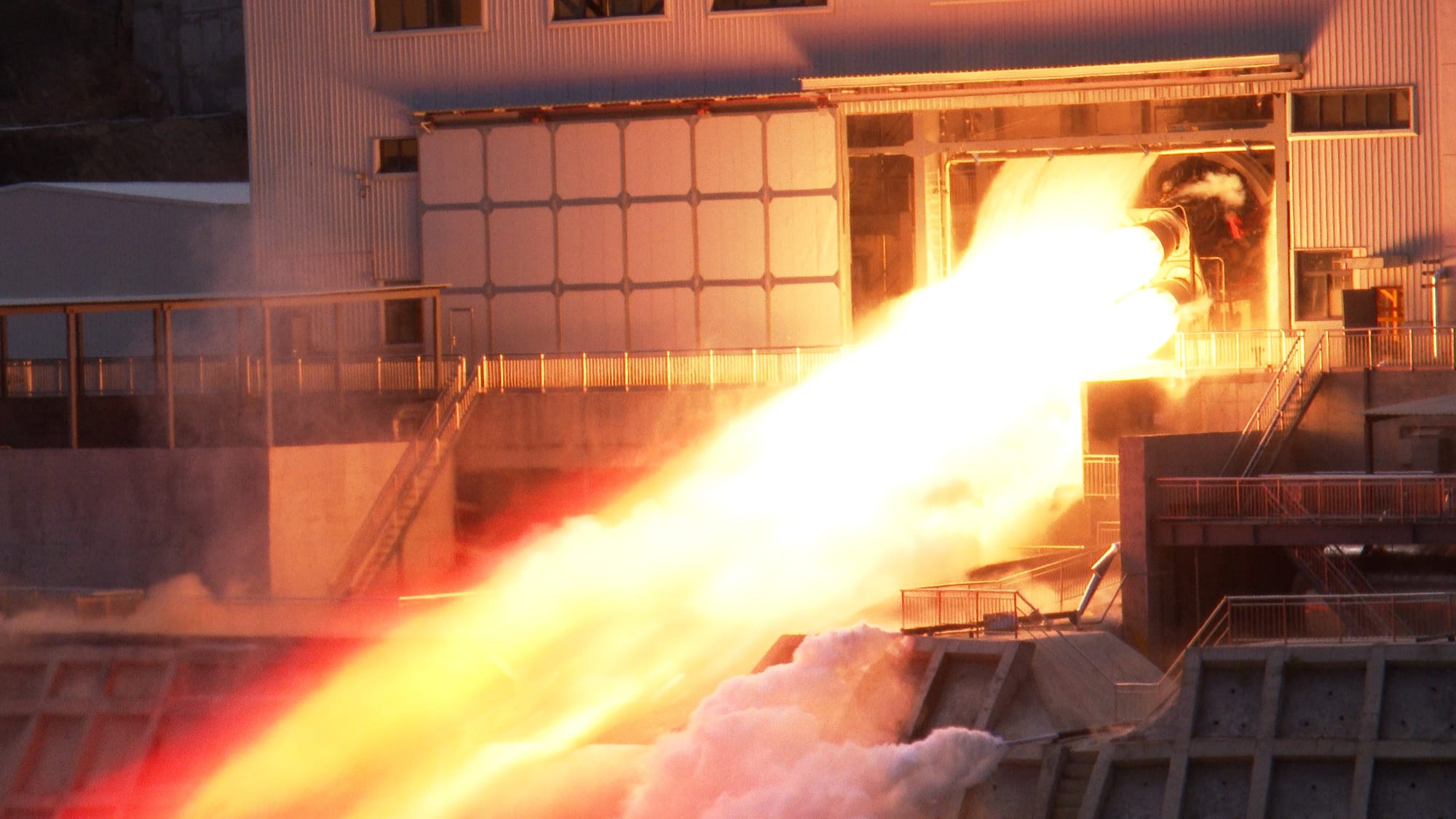
The Cina Aerospace Science and Technology Corporation conducted a test firing of four YF-100K engines together for the first time on the 28th of April. A single one of these engines generates 130 tons of thrust for a combined 520 tons of thrust during the test, however it was not revealed how long the test firing lasted.
This test was reported as testing a liftoff-like scenario according to Li Bin, a Deputy Head of the Xi'an Academy where the engines were tested. The test is believed to have proven that the engines can handle the thermal environment and are ready for flight, more tests may occur however.
The YF-100K engines will be used on the Shanghai Academy of Spaceflight Technology's Long March 12 vehicle, which is 3.8 meters in diameter and has two stages, with both burning rocket-grade kerosene and liquid oxygen. The claimed payload capacity is 10,000 kilograms to a low Earth orbit or 6,000 kilograms to a 700-kilometer sun-synchronous orbit. A maiden flight is currently rumoured to occur before the end of October.
Axiom's lunar suit completes first dive
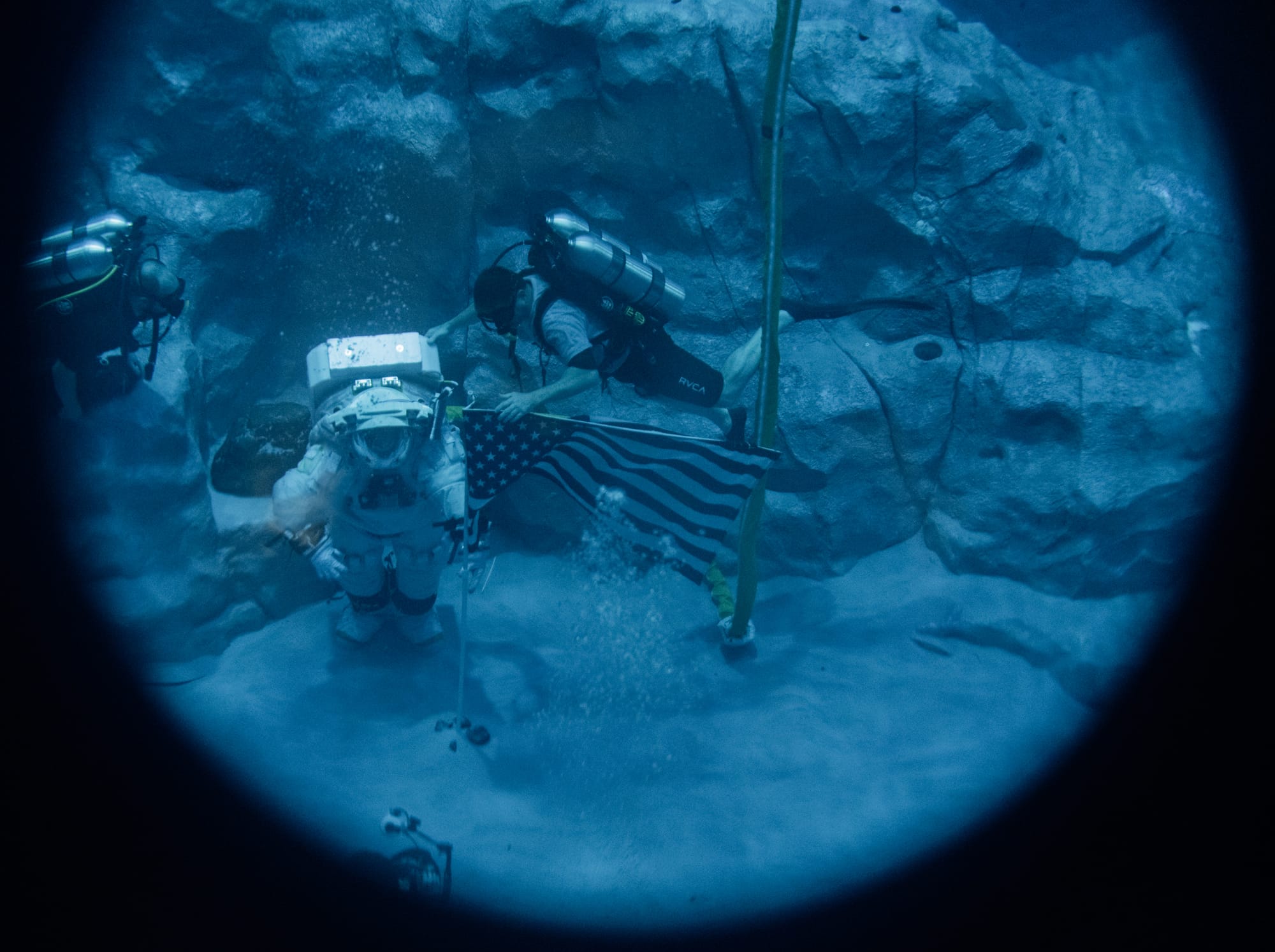
Axiom Space's AxEMU lunar spacesuit completed a test recently in NASA's Neutral Buoyancy Laboratory, this was the first time the suit was submerged for testing. For these tests, the suit was unoccupied with weights inside instead to simulate a person standing in 1/6th gravity on the lunar surface.
The tests were reportedly a success with another test already planned in the Neutral Buoyancy Laboratory, but with an astronaut inside.
Axiom Space's AxEMU, Axiom Extravehicular Mobility Unit, spacesuit is currently expected to be the suit astronauts will use during the Artemis III mission. The suit is reportedly building off of NASA's xEMU, Exploration Extravehicular Mobility Unit, spacesuit which began being designed as a replacement for the spacesuits used on the International Space Station.
SpaceX completes CRS-30 mission
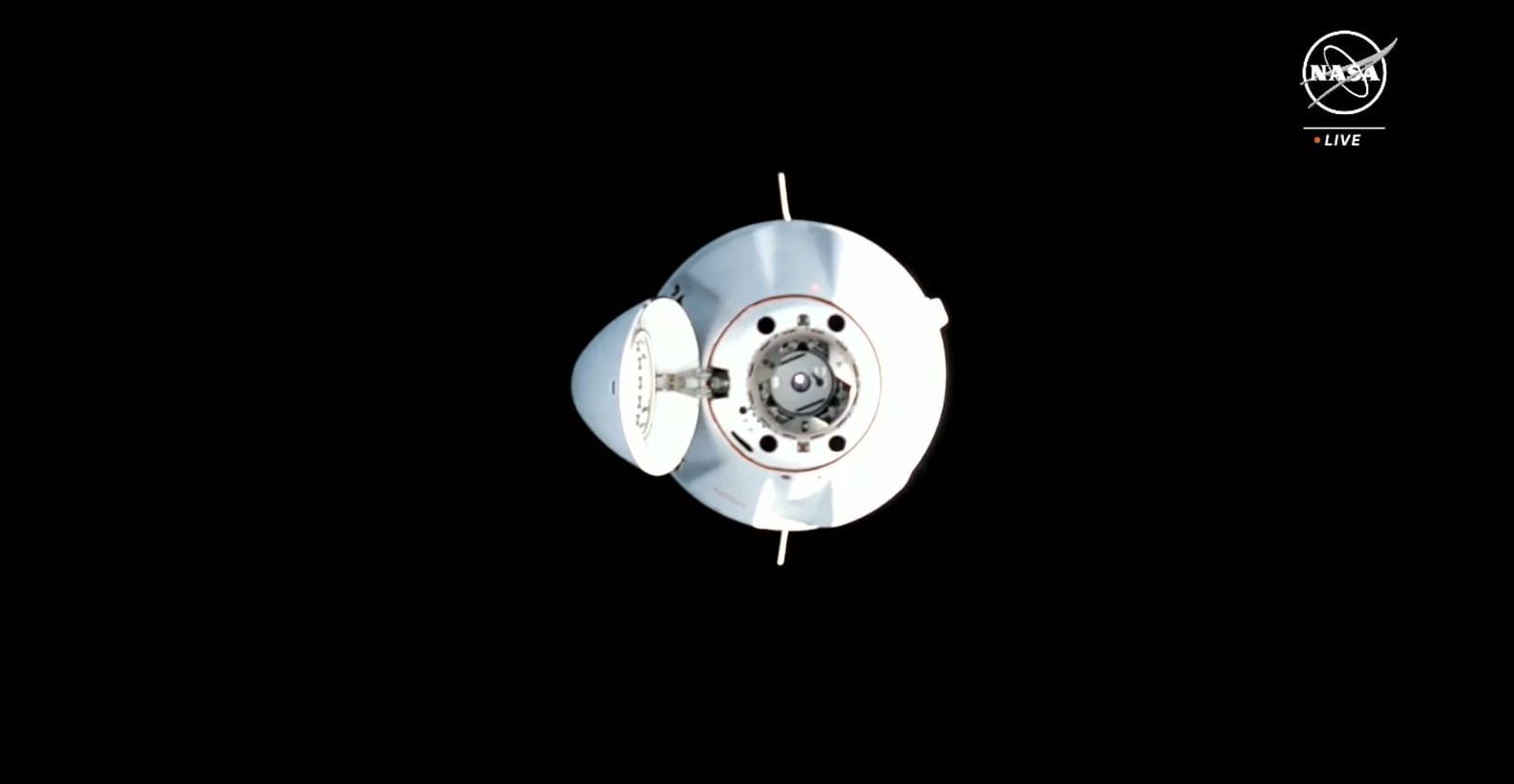
SpaceX concluded its thirtieth cargo resupply mission to the International Space Station on the 30th of April. The mission launched back on the 21st of March, docked with the space station two days later on the 23rd, and departed on the 28th of April. The Cargo Dragon V2 spacecraft that flew on the mission was C209, making its fourth flight.
The spacecraft is also believed to have returned the following items from the International Space Station (via NASA):
- Common Cabin Air Assembly Heat Exchanger – The exchanger performs heat-transfer functions and removes moisture from the ambient on-orbit air. This unit is being returned for analysis and repair and then returned on a later flight.
- Oxygen Generation Assembly Pump – The pump converts potable water from the water recovery system into oxygen and hydrogen. The oxygen is sent to the crew cabin and the hydrogen is either vented or used to produce additional water. The pump is being returned for repair and will return on a later flight.
- Air Quality Monitor – The monitor is intended to improve the air analysis aboard the space station by measuring volatile organic compounds. The monitor is being returned for potential refurbishment of some of its components.
- Water Separator Orbital Replacement Unit – The unit draws air and condensate mixture from a condensing heat exchanger and separates the two components. The air is returned to the cabin air assembly outlet air-flow stream and the water is delivered to the condensate bus. The unit is being returned for repair.
- Emergency Mask –This unit will be returned to replace retaining rings.
- Emergency Portable Breathing Apparatus O2 Reducer Cylinder Assembly – A cylinder tank that provides 15 minutes of oxygen to a crew member in case of an emergency and is used with a quick don mask. This unit has been depressed and will be inspected, placed in line for refill, and relaunched at a later date.
- Remote Power Controller Module – The module distributes 120 volts of direct current electrical power and provides current limiting and fault protection to secondary loads aboard the space station. Both units are degraded, returning for repair, and will be reworked.
- Separator Plumbing Assembly – Supporting the urine processor assembly, the separator plumbing assembly receives steam condensate from the pressure control and pump assembly and recovers water from the orbital replacement unit. The separator plumbing assembly also controls the flow of water to the fluids control and pump assembly and can detect a pressure regulator failure. It is being returned for refurbishment.
Crew rotation on China's space station
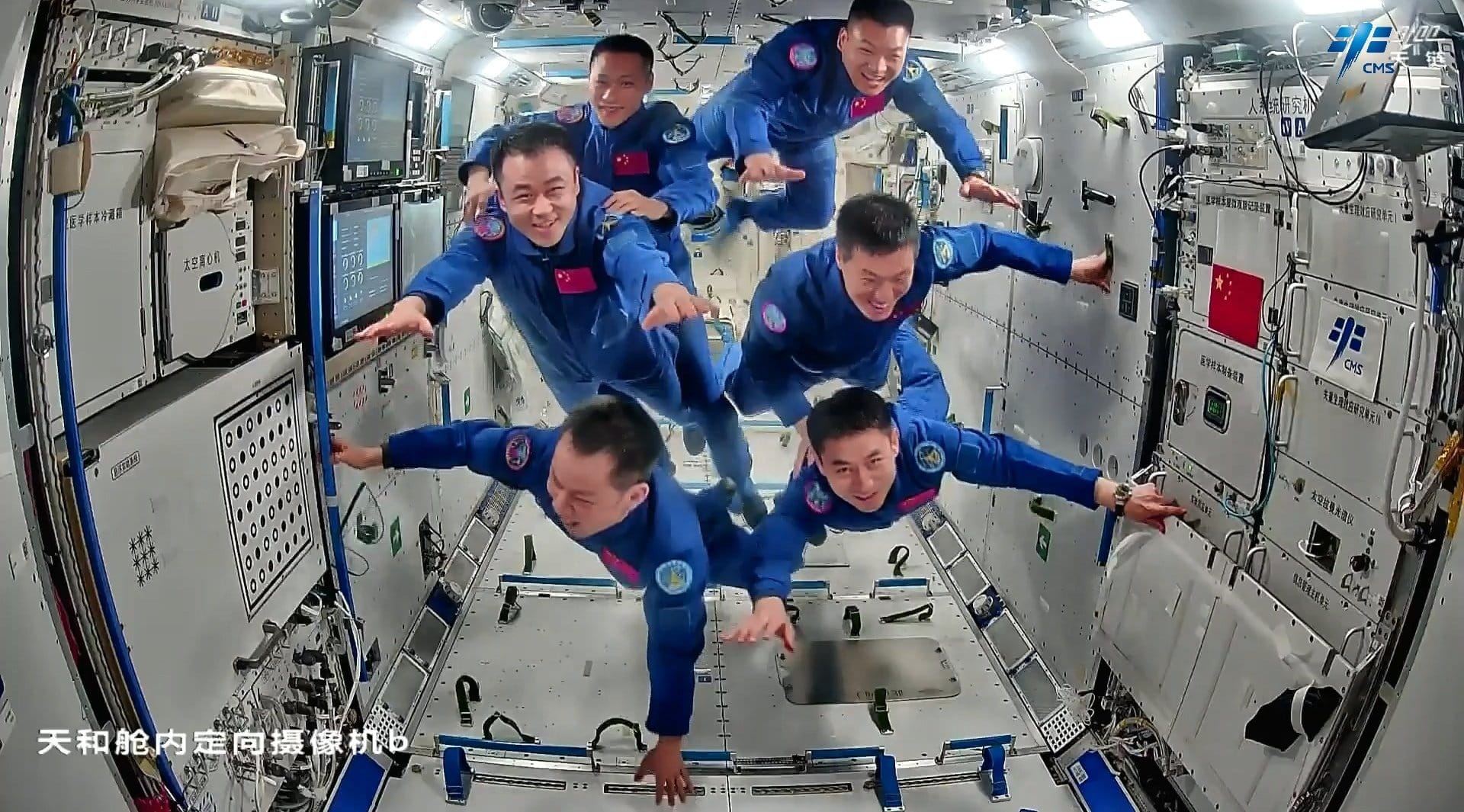
The China Manned Space Agency has conducted a crew rotation for its Tiangong Space Station to maintain a permanent presence aboard the station. A new crew, Shenzhou-18 with Ye Guangfu (叶光富), Li Cong (李聪), and Li Guangsu (李广苏), launched to the space station on the 25th of April at 12:59 pm Universal Coordinated Time. Upon docking and opening the hatch, they were met by the Shenzhou-17 crew, Tang Hongbo (汤洪波), Tang Shengjie (唐胜杰), and Jiang Xinlin (江新林), who had been on board since late October of 2023.
A few days after the arrival of the new crew, the two crews held a handover ceremony where the 'keys' to the station were handover to Ye Guangfu from Tang Hongbo, making Ye the commander of the station.
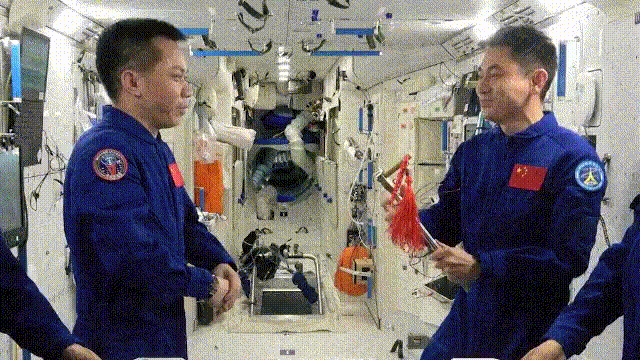
The two crews spent five days together before the Shenzhou-17 boarded their spacecraft and undocked from the station on April 30th. They safely returned to Earth a few hours later and touched down at the Dongfeng landing site in the Inner Mongolia region of northern China.
SES to acquire Intelsat

SES and Intelsat announced on April 30th that Intelsat would be acquired by SES in a 3.1 billion United States dollar, or 2.4 billion Euro, deal. Both companies' press releases say that the acquisition will create a stronger multi-orbit operator with greater coverage, improved resiliency, expanded suite of solutions, enhanced resources to profitably invest in innovation, and benefit from the collective talent, expertise, and track record of both companies.
The press releases of both SES and Intelsat also highlight four key points:
- Value accretive transaction underpinned by €2.4 billion (NPV) of readily executable synergies.
- Creating a stronger multi-orbit operator with ~60% of revenue in high growth segments.
- Enhances competitive offerings to deliver customer value through segment-relevant solutions.
- Expanded cash flows, profitable growth outlook, & strong balance sheet drive total shareholder return.
The acquisition is currently undergoing relevant regulatory clearances and filings, which are expected to be completed in the second half of 2025. Once the acquisition is complete SES will own 100% of Intelsat.
Launches of the Month
This month saw nineteen launches worldwide, if you want to know each launch was we have them all listed below!
April 2nd - Falcon 9 with Starlink Group 7-18
SpaceX started the launches for April from Space Launch Complex 4E, in California, with twenty-two Starlink satellites being placed into low Earth orbit by Falcon 9. The booster for this mission was B1071 making its fifteenth flight and landing successfully on the drone ship 'Of Course I Still Love You' downrange.
April 2nd - Long March 2D with Yaogan-42A
China launched its first mission of the month with a Long March 2D lifting off from the Xichang Satellite Launch Center carrying the Yaogan-42A satellite into low Earth orbit. Yaogan-42A is a remote-sensing satellite intended to help with land surveying, disaster prevention, and monitoring of the Earth below.
April 5th - Falcon 9 with Starlink Group 6-47
SpaceX launched twenty-three more Starlink satellites, this time from Space Launch Complex 40, in Florida. The booster for this mission was B1069 making its fourteenth flight and successfully landing downrange on the drone ship 'A Shortfall Of Gravitas'.
April 7th - Falcon 9 with Starlink Group 8-1
SpaceX launched another twenty-one Starlink satellites from Space Launch Complex 4E. The booster for this mission was B1081 making its sixth flight and landed on the drone ship 'Of Course I Still Love You' downrange successfully.
April 8th - Falcon 9 with Bandwagon 1
SpaceX launched its first Bandwagon dedicated mid-inclination rideshare mission to low Earth orbit from Launch Complex 39A, in Florida. Payloads aboard the Falcon 9 were Capella Space’s Acadia-4, iQPS’s QPS-SAR No. 7, South Korea’s 425SAT, Tyvak International’s Centauri-6, ata Advanced Systems Limited’s TSAT-1A, and HawkEye 360’s Clusters 8 & 9.
The booster for this mission was B1073 making its fourteenth flight and landing successfully back at Landing Zone 1 at Cape Canaveral.
April 9th - Delta IV Heavy with NROL-70
The final Delta IV Heavy took off from Space Launch Complex 37B carrying a classified satellite on behalf of the United States' National Reconnaissance Office. Despite the payload being classified, it likely was an Orion signals intelligence satellite. For more about the launch and Delta IV Heavy see here.
April 10th - Falcon 9 with Starlink Group 6-48
Twenty-three Starlink satellites were carried into low Earth orbit atop of Falcon 9 from Space Launch Complex 40. The booster for this mission was B1083 making its second flight and successfully landing downrange on the drone ship 'Just Read The Instructions'.
April 11th - Angara A5 for a test flight
An Angara A5 launched from the Vostochny Cosmodrome carrying a mass simulator payload for a test flight to geostationary orbit. The rocket successfully completed the test flight to geostationary orbit, and manoevoured into a graveyard orbit afterwards.
April 11th - Falcon 9 with USSF-62
SpaceX launched a Falcon 9 from Space Launch Complex 4E, in California, carrying the Weather System Follow-on satellite into a polar orbit on behalf of the United States Space Force and Department of Defense. The booster for this mission was B1082 making its third flight and successfully landing back at Landing Zone 4 at the Vandenberg Space Force Base.
April 13th - Falcon 9 with Starlink Group 6-49
Another twenty-three Starlink satellites were carried into low Earth orbit atop of a Falcon 9 from Space Launch Complex 40. The booster for this mission was B1062 making its twentieth flight, a new record for a Falcon 9 booster, and landed successfully on the drone ship 'A Shortfall Of Gravitas' down range.
April 15th - Long March 2D with Gaojing-3 (01)
China launched its second mission in April, with a Long March 2D lifting off from the Jiuquan Satellite Launch Center to a sun-synchronus orbit. Onboard the rocket was the Gaojing-3 (01) satellite built by the China Association for Science and Technology for use with China Siwei Survey and Mapping Technology Co Ltd for commercial Earth observation services.
April 17th - Falcon 9 with Starlink Group 6-51
SpaceX added another twenty-three Starlink satellites to its low Earth orbit internet constellation from Launch Complex 39A, in Florida. The booster for this mission was B1077 making its twelfth flight and landing successfully downrange on the drone ship 'Just Read The Instructions'.
April 18th - Falcon 9 with Starlink Group 6-52
Another batch of Starlink satellites were launched atop of a Falcon 9 from Space Launch Complex 40, in Florida, into low Earth orbit. The booster was B1080 making its seventh flight and successfully landed on the drone ship 'A Shortfall Of Gravitas' downrange.
April 21st - Long March 2D with Yaogan 42B
A Long March 2D launched from the Xichang Satellite Launch Center carrying the Yaogan 42B satellite to low Earth orbit, this was China's third launch of the month. The satellite is a remote-sensing satellite and will help with land surveying, disaster prevention, and monitoring of the Earth below.
April 23rd - Falcon 9 with Starlink Group 6-53
SpaceX launched another Falcon 9 launching twenty-three more Starlink satellites into low Earth orbit from Space Launch Complex 40, in Florida. The booster for this mission was B1078 making its ninth flight and landing successfully on the drone ship 'Just Read The Instructions' downrange.
April 23rd - Electron for 'Beginning Of The Swarm'
A few minutes later on the same day, Rocket Lab launched its Electron rocket from Launch Complex 1B on the Māhia Peninsula, in New Zealand. The rocket was carrying two payloads onboard: NASA's Advanced Composite Solar Sail System technology demonstration mission, and NeonSat-1 from South Korea.
April 25th - Long March 2F/G with Shenzhou-18
For its fourth launch of April, China launched another crew to its Tiangong Space Station from the Jiuquan Satellite Launch Center atop of a Long March 2F/G rocket. The crew aboard the Shenzhou-18 mission are Ye Guangfu, Li Cong, and Li Guangsu. For more about the Shenzhou-18 crew and their mission click here.
April 28th - Falcon 9 with Galileo L12
Europe had two of its Galileo satellites launched atop of a Falcon 9 from Launch Complex 39A. The satellites were delivered to a medium Earth orbit by the Falcon 9's second-stage. The booster for this mission was B1060 making its twentieth and final flight as it was expended due to performance requirements.
April 28th - Falcon 9 with Starlink Group 6-54
Ending the launches for April, SpaceX launched yet another Falcon 9 carrying twenty-three more Starlink satellites into low Earth orbit from Space Launch Complex 40, in Florida. The booster for this mission was B1076 making its thirteenth flight and landing on the drone ship 'Just Read The Instructions' downrange.
Launches to look out for in May!
May looks to be another busy month with a few notable missions. Listed below are all of the launches expected or very likely to happen next month, launches on the 1st of May have already occurred due to when this newsletter is published.
May 1st - Falcon 9 with WorldView Legion 1 & 2
SpaceX is expected to launch two WorldView Legion satellites for Maxar to a sun-synchronus orbit from Space Launch Complex 4E, in California. The booster for the mission is currently unknown but is planned to land at Landing Zone 4, at Vandenberg Space Force Base.
May 2nd - Falcon 9 with Starlink Group 6-55
SpaceX is expected to launch yet another batch of Starlink satellites from Space Launch Complex 40 to low Earth orbit. The booster for this mission is currently unknown.
May 3rd - Long March 5 with Chang'e 6
China is expected to launch its Chang'e 6 lunar far-side sample return mission from LC-101 at the Wenchang Space Launch Site. This will be the eighth launch of the Long March 5.
May 4th - Starlink Group 8-2
SpaceX is once again expected to launch another batch of Starlink satellites to low Earth orbit. This launch is expected to occur from Space Launch Complex 4E.
May 7th - Atlas V with Starliner Crewed Flight Test
United Launch Alliance is expected to launch Boeing's Starliner spacecraft into low Earth orbit carrying astronauts Barry Wilmore and Suni Williams onboard. The mission is the first crewed test flight of the Starliner spacecraft, and its second trip to the space station.
May 22nd - Electron for 'Ready, Aim, PREFIRE'
Rocket Lab is expected to launch two CubeSats for NASA's PREFIRE, Polar Radiant Energy in the Far-InfraRed Experiment, mission. The launch is expected to occur from Launch Complex 1B on the Māhia Peninsula, in New Zealand.


